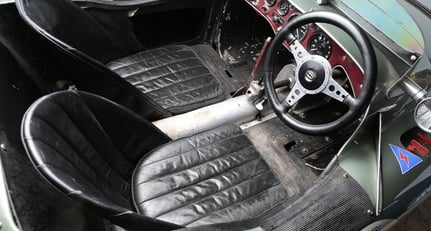1947 HRG 1.5 Le Mans
-
Year of manufacture1947
-
Chassis number92
-
Engine numberM0095
-
Lot number50
-
DriveLHD
-
ConditionUsed
-
Number of seats2
-
Location

-
Exterior colourOther
-
Drivetrain2wd
-
Fuel typePetrol
Description
Ex-works; L'Écurie du Lapin Blanc; 1949 Le Mans
1947 HRG Le Mans Lightweight Sports
Registration no. HXR 530
Chassis no. 92
Engine no. M0095
In 1935, twelve years after the dissolution of the GN cyclecar company, the 'G' - H R Godfrey - was back in business with new partners E A Halford and G H Robins, the trio's new firm adopting the name 'HRG'. The aim was to build a lightweight Vintage-style sporting car endowed with the virtues of brisk acceleration and positive steering, and in this they succeeded brilliantly. However, with its Meadows engine at the end development, an alternative was needed and the firm turned to Singer, adopting tuned versions of the latter's overhead-camshaft engines for its 1500 and 1100 models. Hand built in limited numbers, the HRG was one of the best performing all-round 1½-litre sports cars of its day, as evidenced by class wins at Le Mans in 1939 and 1949.
By the early 1950s demand for HRG's traditional sports car was declining and the firm responded with a radical new design by its technical director Stuart Proctor: the Twin Cam. The latter was powered by a 1,497cc Singer SM engine fitted with a twin-cam cylinder head, mounted in a new twin-tube chassis featuring all-independent suspension, alloy wheels and four-wheel disc brakes. As such the Twin Cam represented the state of the art in contemporary sports car design. Unfortunately, Rootes' take-over of Singer in 1956 halted the supply of engines, and HRG production ceased after only three Twin-Cam production cars, plus the prototype, had been completed.
The HRG, like the Frazer Nash and the AC, represented the last of the hand-built, high quality sports cars equally usable on both road and track. Already, mass-produced and far cheaper cars from the likes of MG, Jaguar and Triumph were on the market, while the future - in sporting terms - would belong to purpose-built racing machinery from Lotus, Lola, Cooper et al. When production ceased, HRG had sold approximately 240 cars, the vast majority of which survive today.
This car, chassis number '92', was originally built in 1947 as one of only 35 '1500 Aerodynamic' models, complete with all enveloping coachwork. First owner Jack Scott campaigned the car in international events under the works' 'L'Écurie du Lapin Blanc' team banner, notable successes being a 7th place in the Manx Cup and winning the Isle of Man Empire Trophy team prize.
In 1948, a 2nd place in the Grand Prix des Frontières at Chimay in Belgium was followed by a 9th in class and the team prize at the Spa 24 Hours race. It was for this race that the innovative team leader Peter Clark arranged for the cars to carry two-way radios to aid team tactics and pit work, a commonplace occurrence today but unheard of then. 'HXR 530' is probably one of the first racing cars ever to carry such equipment. The season was completed with the Paris 12-Hour race at Montlhéry.
For 1949, 'L'Écurie du Lapin Blanc' decided on another serious attempt at Le Mans and used 'HXR 530' and its two sister-cars as prototypes for a new body. The aerodynamic body was removed and a lightweight one with fully exposed wheels and a smaller frontal area was designed and built by Monaco Motors under the direction of John Wyer, who would later manage the endurance racing campaigns of Aston Martin, Ford Motor Company and Gulf Oil.
The three identical cars were prepared with the sole idea of racing for 24 hours and winning. All details and measurements conformed exactly to the then current FIA sports car racing regulations, while the standard engine was mildly modified and much attention paid to lightness. Unfortunately, 'HXR 530' broke down during the race with a cracked block after 83 laps, but Eric Thompson and Jack Fairman went on to win the 1,500cc class and finish 8th overall in their similar car. Immediately after the race, the HRGs were transported to Brussels and overhauled in preparation for the Spa 24 Hours race, held only two weeks later. A 19th overall and 3rd in class for 'HXR 530' helped 'L'Écurie du Lapin Blanc' claim the team prize and the Richard Seaman Cup for best placed British car.
After the 1949 season, all three cars were sold to Len Gibbs. Len and his wife Ruby sold two of them but kept 'HXR 530' for themselves and raced it extensively throughout the 1950s, with notable successes at both Goodwood and Silverstone (see results list on file). Early in 1953 the coachwork was changed again, on this occasion to the barchetta body as seen today in preparation for Goodwood that year. Gibbs also shortened the wheelbase. The accompanying original logbook lists two members of the Goulden family of Stanmore, Middlesex as 3rd and 4th owners, followed by one Reuben Archer of Teddington, Middlesex and then Anthony Searson of Woking, Surrey. The last stamp on the logbook is dated August 1969.
'HXR 530' has been with its current owners for around eight years and has been restored to the specification it had during the Gibbs' ownership, removing the supercharger fitted by the previous owner Tony Searson. The car is still raced regularly at historic events such as the Silverstone Classic, Le Mans Classic and Le Mans Legends races. Highlights of this more recent phase of its competition career include pole position at the 2009 Le Mans Legends and a 'Class 1' win in that same event in 2013. While in the vendor's ownership the car has been completely rebuilt by Chris Connelly and Mass Racing Engines, who have continued to maintain it to a very high standard. The engine currently installed is a highly tuned Singer SM single-cam unit, similar to the 1949 Le Mans engine
Very swift and a proven class winner, 'HXR 530' comes with current HTP papers, is 'on the button' and ready to race. In short: this is an extremely rare and historic British sports-racer, capable of winning its class in the right hands, which is relatively cheap to run and eligible for a wide variety of the most prestigious motor sports events.
















